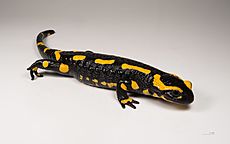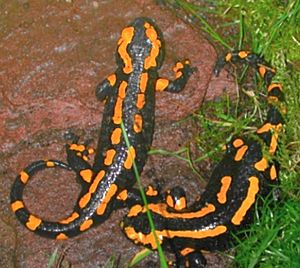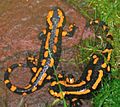Fire salamander facts for kids
Quick facts for kids Fire Salamander |
|
|---|---|
 |
|
| Conservation status | |
| Scientific classification | |
| Kingdom: | |
| Phylum: | |
| Class: | |
| Order: | |
| Family: | |
| Genus: |
Salamandra
|
| Species: |
S. salamandra
|
| Binomial name | |
| Salamandra salamandra |
|
The Fire Salamander (Salamandra salamandra) is a well-known salamander species found in Europe. These cool amphibians are mostly black. They have bright yellow spots or stripes. Sometimes, you might even see shades of red or orange mixed in with the yellow. The exact colors and patterns depend on the specific type of Fire Salamander.
Fire Salamanders can live for a very long time. One salamander at a museum in Germany lived for more than 50 years! That's older than most pets.
Contents
Where Fire Salamanders Live and What They Eat
Fire Salamanders make their homes in forests across the hilly parts of southern and central Europe. They especially like forests with trees that lose their leaves in autumn. They often hide under fallen leaves or mossy tree trunks.
These salamanders need clean, small brooks (which are like tiny rivers) in their living areas. These brooks are important for their young to grow. Fire Salamanders are good at staying hidden. You might not even notice them on land or in the water. They spend a lot of time tucked away under stones, wood, or other objects.
Fire Salamanders are usually active in the evening and at night. But if it's a rainy day, you might spot them moving around during the daytime too. They love to eat insects, spiders, earthworms, and slugs. Sometimes, they might even eat small animals with backbones, like newts or young frogs. They catch their food using their teeth or by sticking out the back part of their tongue, which is sticky.
How Fire Salamanders Reproduce
Male and female Fire Salamanders look quite similar. But during the time they mate, the male has a swollen gland near its rear end. This gland creates a special packet called a spermatophore, which holds the male's sperm.
Their courtship (when they try to find a mate) happens on land. When a male finds a female he wants to mate with, he will block her path. The male then places his spermatophore on the ground. The female picks up this sperm packet, and that's how reproduction happens. Unlike some other amphibians, Fire Salamanders do not stay in their larval (young) stage for too long. They develop lungs and live on land as adults.
How Fire Salamanders Protect Themselves
If a predator tries to grab a Fire Salamander, it has ways to defend itself. Besides striking certain poses to scare off attackers, adult Fire Salamanders can produce strong poisons. These poisons usually affect the nerves of the predator. One such poison is called Samandarin.
When a salamander feels danger, it can release this poison through its skin. Samandarin can cause strong muscle spasms and high blood pressure in animals that try to eat it. The poison glands of the Fire Salamander are mostly found around its head and on its back. The bright colors on the salamander's skin often show where these glands are. While some of these skin liquids might help protect the salamander from germs, some can be dangerous to humans.
Where Fire Salamanders Are Found
Fire Salamanders live in most parts of southern and central Europe. They are most often found in places that are between 400 and 1000 meters (about 1,300 to 3,300 feet) above sea level. Sometimes, in northern Germany, they can be found as low as 25 meters (80 feet). But in places like the Balkans or Spain, they are also commonly found at much higher altitudes.
Different Types of Fire Salamanders
There are several different types, or subspecies, of the Fire Salamander. Two notable ones are fastuosa and bernadezi. These two are special because they give birth to live young. Most other Fire Salamander subspecies lay eggs that hatch inside the mother's body, and then the young are born.
Here are some of the recognized subspecies:
- S. s. alfredschmidti
- S. s. almanzoris – Also called the Spotted Fire Salamander
- S. s. bernardezi
- S. s. fastuosa – Also called the Yellow Striped Fire Salamander
- S. s. gallaica – The Portuguese Fire Salamander
- S. s. salamandra - The most common type, also a Spotted Fire Salamander
- S. s. terrestris – The Barred Fire Salamander
Some types that were once thought to be subspecies are now considered their own separate species. This is because scientists have learned more about their genetics.
Images for kids
See also
 In Spanish: Salamandra salamandra para niños
In Spanish: Salamandra salamandra para niños











